Menu
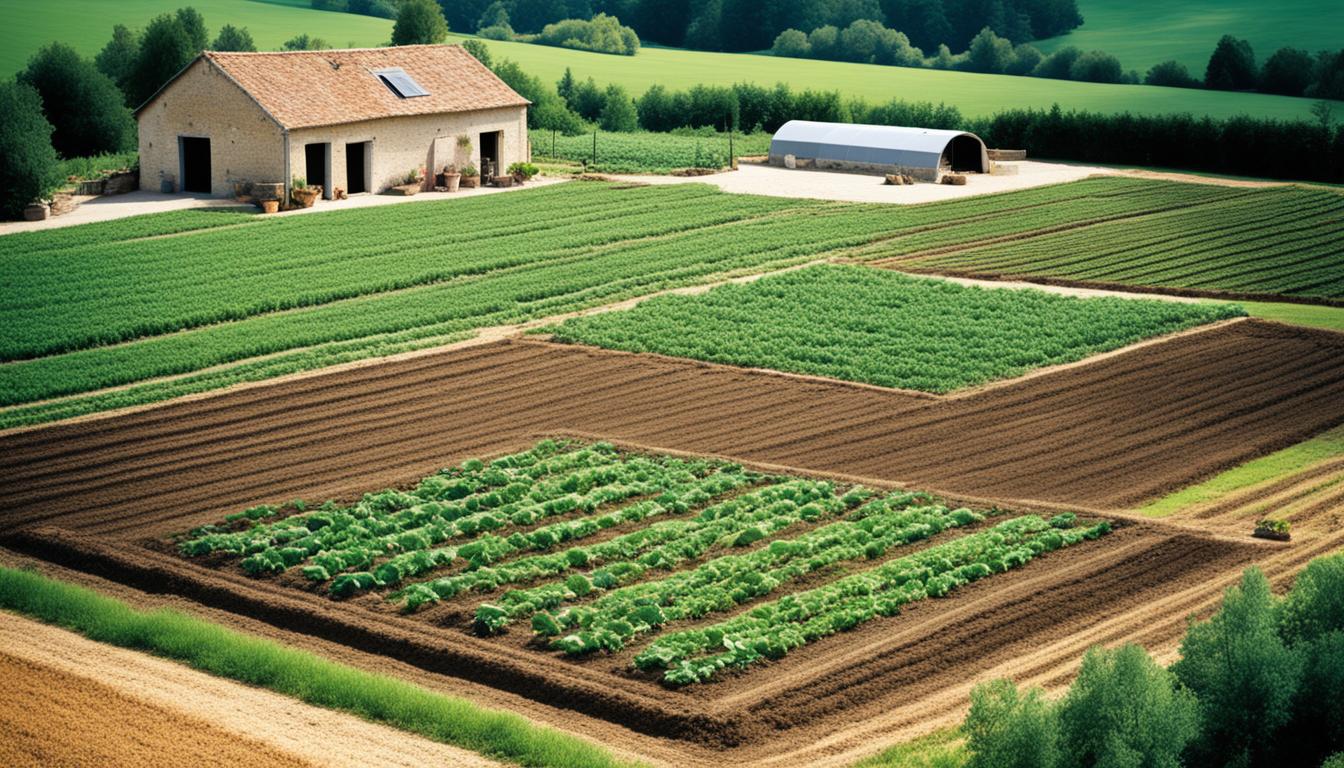
In a family farm in France, they are farming differently. This farm, covering 170 hectares, is focused on keeping the soil healthy. They have stopped tilling the land and plant cover crops. This means the soil stays alive for 300 days each year. It shows they are serious about taking care of the earth. This also brings a new way to look at farming, using organic ideas.
Julien and Géraud, who work on the farm, have a lot of earthworms in their soil. About 2 tonnes per hectare, which is much more than in regular farms. Having loads of earthworms shows the soil is doing well. They plant many types of cover crops to make sure the soil stays balanced. This helps keep the land both healthy and productive.
They also let sheep graze there for half of the year. This not only provides natural fertiliser but also helps break down tough plant remains. This is good for farming in a natural way. The farm works with groups like South Pole and Biospheres. They are leaders in using farming to help the environment.
Their actions make the soil better and help the earth for a long time. They are part of a growing movement for better farming in France.
Soil health is crucial for keeping farms productive and sustainable. It was first highlighted in the early 2000s. Since then, knowing about soil’s condition has become central to good farming.
The state of the soil affects plant growth, environmental health, and future farm earnings.
In France, we see soil health as the soil’s ability to support life. It’s more than just the ground we walk on. It’s a living system that helps plants, animals, and people to thrive. This idea has a few parts:
French farmers mainly use lab tests to check soil health. But they’re starting to see the value in what lives in the soil, too. This biodiversity is key in providing helpful services for the ecosystem.
In France, caring for the soil is key in farming. Good soil brings many benefits that are crucial for the farm to keep going:
Looking after the soil in France has changed. It’s not just about how well crops grow anymore. Tests now also measure water quality, the effect on climate, and food safety. These checks help make sure farming stays sustainable.
There are lots of ways to make soil healthier in France. Farmers can adjust nutrients, add organic matter, use less tillage, and grow a variety of plants. These efforts help with better crops and preserve soil benefits over time.
Soil health is closely linked to clean water. The soil acts like a filter, catching harmful substances. Preventing these pollutants from things like fertilisers, pesticides, and metals is crucial. It keeps our water safe to use.
Taking care of the soil is a big deal in France. It shows a strong commitment to keeping the land and the crops healthy. This is essential for the country’s future and for looking after the environment.
For more insights on soil systems and their comprehensive impacts, please refer to this detailed study.
In France, farmers are using conservation techniques to improve their land. They focus on ways that help plants and animals flourish and make the soil healthier. This includes disturbing the soil as little as possible, keeping it covered, and growing different crops in a cycle.
These methods are becoming more popular as their long-term benefits are clear. But, it’s not easy for farmers to start using them because it involves new ways of working.
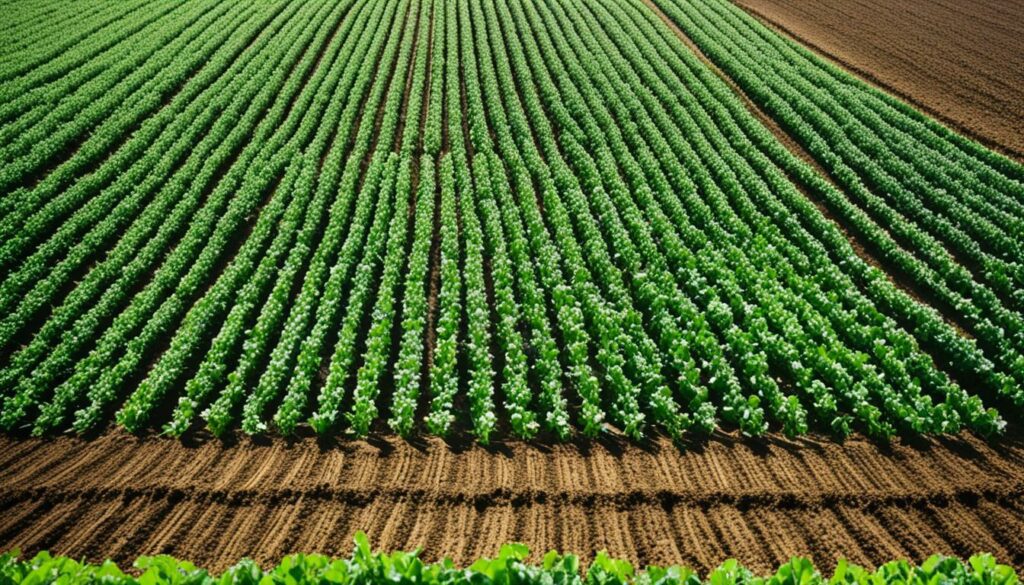
Conservation agriculture is all about caring for the soil without harming it. This means not turning the soil too much, making sure it always has something growing on it, and changing the types of plants you grow regularly. Doing this helps stop the soil getting damaged, keeps it from blowing or washing away, and makes sure the ground stays full of different living things.
In France, Géraud’s family farm is a great example of this. They don’t till the soil and always keep it covered with plants. This way of farming keeps the ground healthy all year round.
Starting these farming methods can be tough. Farmers need to spend money and time to change how they work. They can also face financial problems and feel a lot of stress from the challenges of climate change, like bad weather and more pests.
Working together is key to making this type of farming successful. Everyone, from the farmers to the people who buy their produce, needs to help out.
Géraud’s farm is a good example of what can be achieved. Since 2015, they have seen great improvements in their soil. They have a lot more earthworms now, which shows their land is much healthier than before.
They plant a variety of crops, let animals graze some fields, and have less harm on the environment. This also makes their crops stronger against climate change.
| Farming Practice | Earthworm Density (kg/ha) | Environmental Impact |
|---|---|---|
| Conventional Farming | 100 kg/ha | High Negative Impact |
| Organic Farming with Tillage | 140 kg/ha | Moderate Negative Impact |
| Conservation Agriculture | 2,000 kg/ha | Low Negative Impact |
Another successful project is the “Sols de Bretagne.” It’s working to make 11,000 hectares of land healthier while also fighting climate change. By using better farming techniques, the farms in this project are saving carbon and helping more earthworms and useful insects live in the soil.
In France, the Living Soils Initiative is making a big difference. It was started in 2018 by the Earthworm Foundation. The aim is to help farmers, businesses, and society work together to keep the soil healthy across France. It does this by offering support and financial help, so farmers can switch to better, more sustainable ways of farming.
Helping farmers is key for the initiative’s success. It gives them the tools and knowledge to do regenerative farming. This means they learn to keep their soil organic and full of carbon, making it healthier. By doing this, farmers rely less on equipment and chemicals, saving money. They’re also trying out different plants and ways of planting to make the soil stronger.
Switching to sustainable farming can be hard and expensive. The Living Soils Initiative helps by creating financial support systems. This makes it less risky and more attractive for farmers to try new, earth-friendly ways. The goal is to make it easier for farmers to choose sustainable farming both economically and in practice.
The initiative is changing farming across France. Places like Lidl now sell potatoes grown in a truly sustainable way. This shows that customers want products that are good for the earth. Nestlé, aiming to be carbon neutral by 2050, now gets lots of its potatoes locally from French farmers. This is helping farmers be more successful, both for the planet and their pocketbooks. It proves that the Living Soils Initiative is not just good in theory but also in making real improvements in how we farm sustainably.
Carbon storage in soils is vital, especially for soil health in France. The country’s mix of terrains, like forests and grasslands, boosts soil carbon stocks. For example, forests hold 38% of all soil carbon, while meadows have 22%, and fields grow crops, making up 26.5%. Yet, some areas are losing their carbon over time.
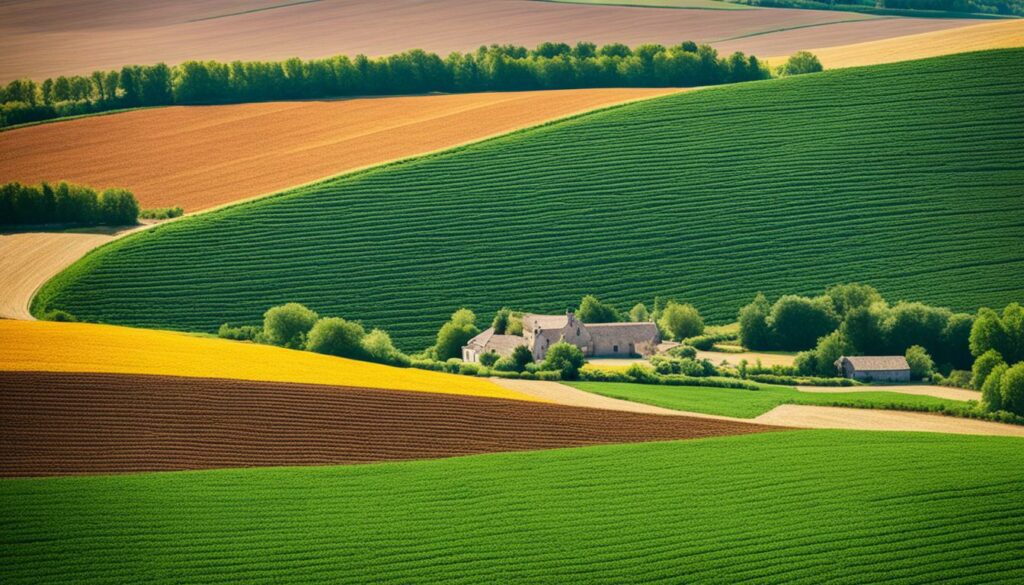
Conservation practices are key in upping soil carbon levels. Cover cropping and less tilling, among others, really help. By using these methods on farm fields alone, France could up its carbon storage by 1.9‰. This equals 86% of the nation’s possible extra carbon storage. Plus, combining these practices could cut 41% of farm carbon emissions.
Looking at ecosystem services in financial terms is getting more attention in France. It helps persuade farmers to go green and reveals the money-earning side of soil. Efforts like the 4 per 1000 study aim to increase carbon storage by 0.4% each year. This push to value services should lead to better land care and help the environment.
| Land Type | Carbon Stock Contribution (%) | Trend |
|---|---|---|
| Forested Land | 38% | Stable |
| Permanent Grasslands | 22% | Slight Depletion |
| Temporary Grasslands & Arable Crops | 26.5% | Downward Trend |
Farmers in France, by embracing extra carbon storage, can aid worldwide climate targets and boost soil health. Their joint push with various groups shows a strong commitment to managing land sustainably and improving soil.
Cover cropping is key in managing soil health. It shields soil against loss, makes it store more water, and builds better soil. All this happens by using natural farming methods to keep a farm going strong for a long time.
Using cover crops helps in many ways. It stops the ground from eroding and lets water soak in better. Plus, it adds plants back to the soil to make it richer. This also helps lots of small life in the dirt, which keeps the soil healthy.
Since 2010, more and more farms have started using cover crops in the EU and UK. By 2016, about 8.9% of farmlands were growing them. In France, less land was left bare over winter in 2017. This shows how farmers are realising the benefits of planting cover crops.
The farm run by Julien and Géraud near Paris is a great example. They use many different cover crops to look after their soil. Their soil’s health and the amount of natural carbon it has have gone up a lot. These methods also help store more carbon from the air and protect different plants and animals.
In France, there are special laws to protect different cover crops that help nature. Thanks to advanced tools in space, we can check how well these plants are growing. These tools also help spot problems like too many weeds and knowing when the cover crops should be removed. Even if there are still some problems, technology is making cover cropping better for the future.
Agroforestry is about farming and growing trees together, making land use better. It improves the land and helps fight climate change by absorbing lots of carbon. This way of farming is becoming more popular for its many good effects.
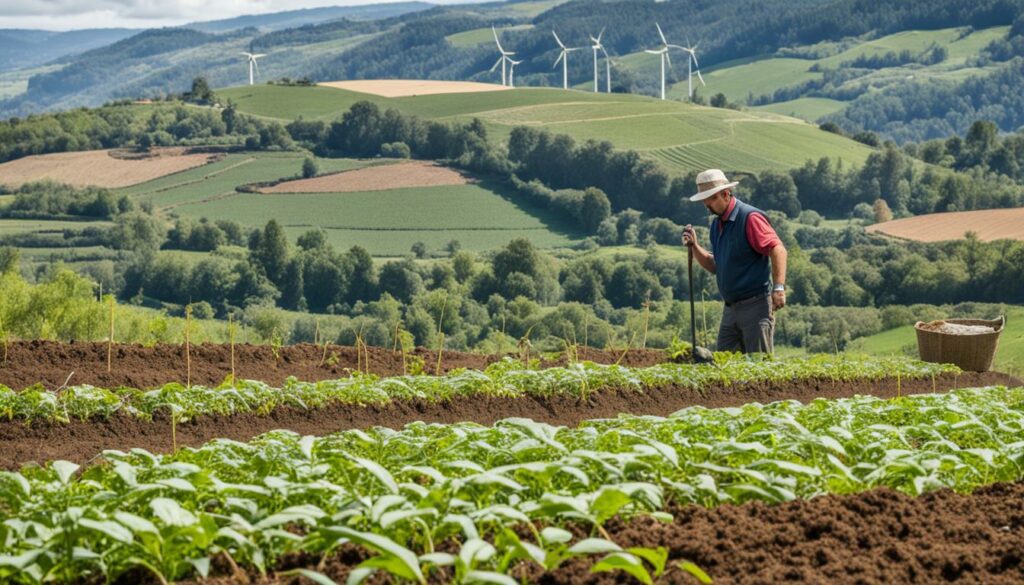
In France, they’re mixing trees with crops in cool ways. Old methods, like mixing orchards with field crops, are keeping the land healthy and productive. This mix adds to the soil and makes a lively area for plants and animals to thrive.
One farm in France is doing amazing things for its soil. By not ploughing and adding plants that cover the soil, they’ve made a place where worms love to be. This method has brought 20 times more earthworms to the soil than usual. This helps the plants grow better and the soil to stay healthy.
| Farm Practice | Conventional Farming | Géraud’s Farm |
|---|---|---|
| Presence of Earthworms (kg/ha) | 100 | 2000 |
Cover crops not only make the soil better but also attract insects that are good for the land. They help stop carbon from going in the air. Using such methods, we can make sure farming is good for the Earth. On Géraud’s farm, sheep help too by adding natural fertiliser and breaking down tough plants, making the soil even better.
Even though there are fewer trees in France’s fields now, agroforestry is getting more common. There are still a lot of tree lines in the country, covering a big area. The country is also putting money into many projects to farm and grow trees together. This shows that many people in France are serious about making farming better for the future.
In some areas, old ways of farming that include fruit trees and meadows are making a comeback. It’s shown that when you grow trees and crops like wheat together, you can get more food from less space. This way, farming becomes more efficient and better for the land.
In France, soil health is improved by techniques like organic farming and cover cropping. These boost the life in soil, attracting useful insects. This makes the farming ecosystem stronger.
Cover cropping improves the soil by preventing erosion and helping it to hold more water. It also makes the soil richer. Conservation tillage is another method. It keeps the soil undisturbed, helping soil creatures and plants grow better.
:
| Country | Total Agricultural Land (million ha) | Percentage Degraded Land | Main Crop | Challenges |
|---|---|---|---|---|
| Australia | 372 | 66% | Wheat | Declining Soil Fertility, Erosion, Salinity |
Soil health is crucial for sustainable agriculture in France. Regenerative agriculture is key to achieving this. It restores ecosystems and profitability, helping biodiversity. We need to spread this knowledge widely to improve many areas.
Good soil practices and a real drive to help the environment work together for France’s farms. They make the land more resilient and productive in the long run.
Switching to organic farming shows a commitment to soil health. It avoids using chemicals and instead boosts soil fertility through natural methods.
Moving from conventional to organic farming aims to enhance soil health. It stops using man-made chemicals, preferring natural ways to feed the soil. This approach leads to better water control in the soil because it’s full of diverse life forms. Organic farms also avoid too much digging to protect the soil’s structure and health. Soils with lots of organic matter keep important nutrients like carbon, nitrogen, and phosphorus well.
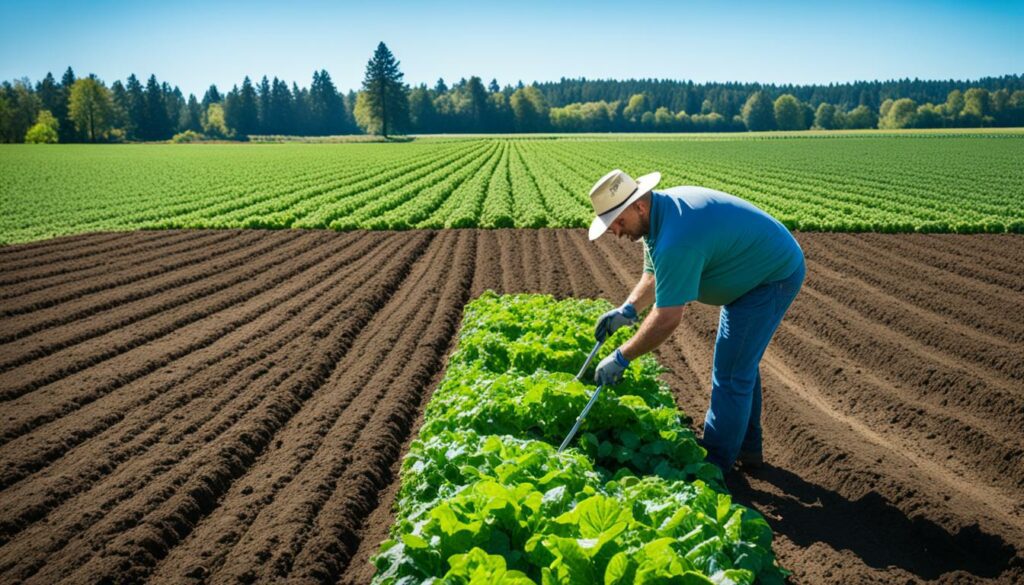
In Northern France, organic farming is making a big difference. Bessette Creek Farm, for example, has seen better soil and less water use thanks to organic methods. Also, Ryan Albinger found success by mixing organic and traditional ways on his farm for economic gain. The Geiger family turned to organics during the farm crisis, showing organic farming’s durability and business value. These stories show how using natural fertilisers and light soil management can improve soil health and keep farming sustainable.
These areas’ move to organic farming highlights big wins for the environment and economy. Their hard work keeps the soil healthy and supports a farming system that lasts.
Farmers in France have a big impact on soil health. But, they face tough challenges in making their farming sustainable. These range from the costs involved to getting used to new farming methods. All this happens as the climate keeps changing.
The push for sustainable farm methods is a big challenge. Mainly because it means moving away from the old ways to new, smart farming. After World War II, farming became all about producing more on the same land. Now, farmers need to think about the land’s health too.
Most French farmers are part of groups helping them farm better. But even with shared resources, farming in a way that’s good for the soil can be expensive at first. For example, using regenerative farming needs early investments.
Then there’s the weather. Climate change is mixing up the usual weather patterns for farming. So, keeping the soil healthy is even more of a challenge, even if it’s critical.
Fortunately, there are support and training programmes for farmers. Programs like Living Soils give them tools to make better farm choices using science. This is a step towards smarter, sustainable farming.
Icosysteme has made a special online hub for farmers. It’s designed to help them find easier ways to learn about keeping the soil healthy.
There’s also support from big names like Nestlé and Lidl. They encourage farming that’s good for the earth by selling products that are grown right. This makes a big difference, helping the planet and the farmers’ incomes.
The Livelihoods Carbon Fund is part of this too. It supports projects that help the soil and reduce carbon. A good example is “Sols de Bretagne.” It shows how helping farmers financial during this change can lead to a lasting positive impact.
France works hard to check soil quality. This helps farmers make smart choices. They check soil at over 2000 sites. This forms the French Soil Quality Network (RMQS). They’ve collected soil samples at the European Conservatory for Soil Samples in Orléans since 2014.
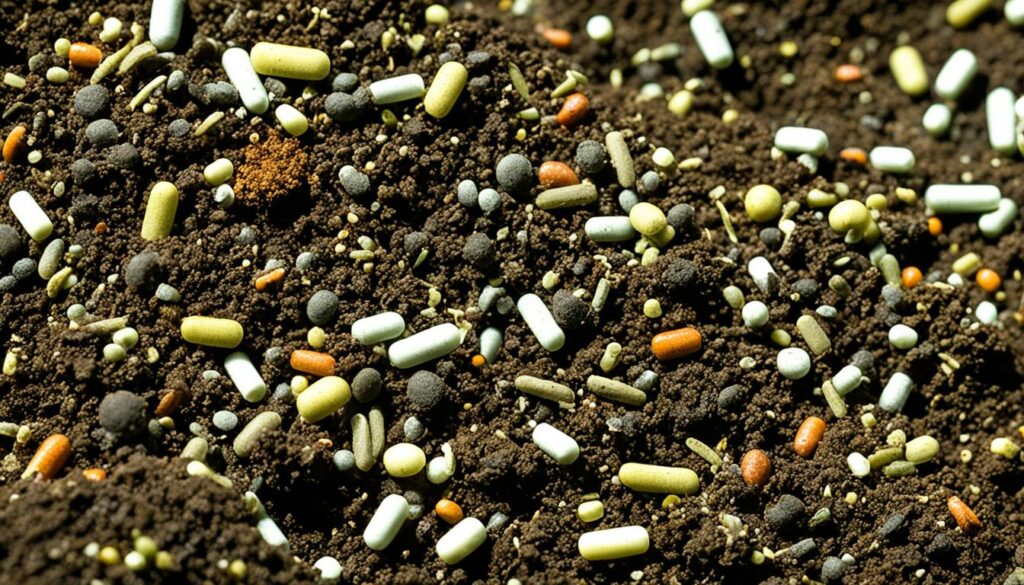
Looking at soil means using complex methods. The DoneSol database, run by InfoSol, has tons of soil info since 1990. This data shows interesting things, like how soil pH is going up. It tells about changes in places like Brittany and Franche-Comté’s soil nutrients.
InfoSol works with the French Geoportal and the IGN to show soil maps for free. This helps a lot. InfoSol is also part of making a global soil data system.
Keeping an eye on soil health is really important. It helps us see how farming affects soil. France uses a lot of pesticides, but they’re trying to lower this. In 2020, 98% of soils had pesticides in them. Most were glyphosate and AMPA. They found these chemicals in high amounts, which isn’t good for earthworms.
To understand soil better, they look at lots of things like size, pH, and nutrients. This helps farmers use better methods. These methods help soil get healthier and keep farming sustainable.
| Parameter | Analysis |
|---|---|
| Particle Size Fractions | Physicochemical examination |
| pH Levels | Trend Analysis |
| Total C, N, P Concentrations | Content Evolution |
| CaCO3 Content | Calcium Carbonate Presence |
| CEC | Cation Exchange Capacity |
The way farming works in France is changing with the use of sustainable agriculture practices. Farms like Géraud’s have started using techniques such as no-till and cover cropping. These methods have made a big difference in soil health in France since 2015.
Géraud’s farm keeps the ground covered with plants for most of the year. This has stopped water and soil from being washed away during 2022’s floods. It’s also brought about a huge increase in the number of earthworms, which is great for the soil.
Cover crops are vital for improving the soil at Julien and Géraud’s farm. They plant mixes of five to ten different plants. This helps the soil’s structure, increases nitrogen, and grows more plant material. Having sheep graze for half the year adds natural fertiliser and breaks down hard plant remains.
Sustainable agriculture practices are also helping with carbon sequestration. This is very important as the world’s population is expected to reach 8.9 billion by 2050. Farms working together with groups like Biospheres get the help they need to turn these eco-friendly ideas into reality.
Moving from harmful chemicals to sustainable farming is key. Research shows that methods like organic farming and careful tillage improve the soil a lot. They boost the activity of tiny soil organisms and increase the number of different plants. Doing this means fewer problems with soil erosion and healthier soil all around, making soil health in France better.
The table below shows clearly how much better for the land Géraud’s ways are compared to usual farming:
| Farming Practice | Earthworms per Hectare | Additional Benefits |
|---|---|---|
| Conventional Farming | 100 kg | Limited biodiversity |
| Organic Farming (with tillage) | 140 kg | Improved soil biota |
| Géraud’s Regenerative Farming | 2 tonnes | Enhanced carbon storage, biomass generation, and biodiversity |
In France, new techniques for soil fertility are making agriculture more sustainable. Farmers are using methods like changing the crops they grow each season, adding natural materials to the soil, and using less machinery to work the land. This helps the soil stay healthy and full of nutrients. It is key to keeping farms productive for years to come.
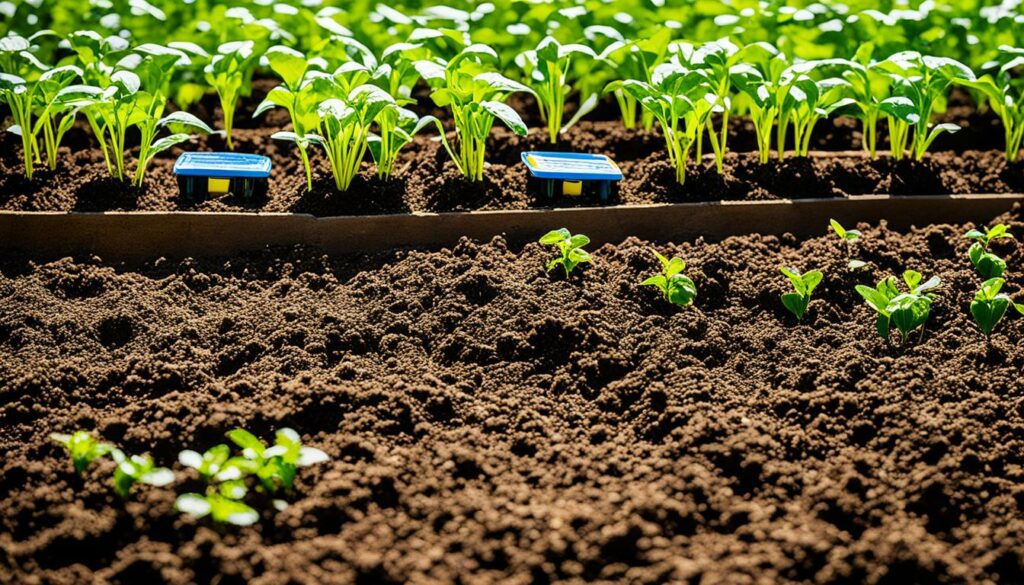
Introducing these new ways to manage soil health is not easy. It involves many steps. For instance, growing different plants in the same field each year can stop pests and make the soil stronger. Adding things like compost and animal waste makes the soil richer in nutrients. And using machines less keeps the soil’s friends, like earthworms, in good shape and stops the soil from washing away.
The outcomes of these fresh approaches are really encouraging. Farmers see that the soil becomes better at holding water and nutrients. They notice more kinds of plants and animals come back to their farms. This not only makes their crops grow better but also makes their land more resilient against problems. Below, find examples of the improvements:
| Technique | Benefits |
|---|---|
| Crop Rotation | Improved biodiversity, reduced pest and disease pressure |
| Organic Amendments | Enhanced soil structure, increased nutrient availability |
| Reduced Tillage | Preserved soil integrity, reduced erosion, enhanced soil microorganisms |
To sum up, taking on these new methods for keeping soil rich promises a better way forward for farming. These approaches mean not only more crops today but also healthier farms for tomorrow.
The Earthworm Foundation leads the Living Soils Project in France. Since 2018, it has been working in Northern France. This area is famous for its strong farming history. The project has brought together 500 farmers, 20 suppliers, and cooperatives, plus top brands and educational groups. Together, they’re boosting soil health in ways that help all of France.
The Living Soils Project makes a big impact by supporting Nestlé’s factory in Northern France. This site turns 500 tons of potatoes from 160 local farms into products every day. These farms use regenerative agriculture, which helps the land stay healthy. Nestlé then buys from these farms. This closes the loop, showing how everyone benefits from sustainable farming.
Lidl has also joined in, selling potatoes grown using regenerative methods since October 2021. They’re in all 1,570 Lidl supermarkets across France. This move supports the Living Soils Project’s larger goal of focusing on soil health. It proves that large retailers can encourage sustainable practices. This helps France’s farmlands thrive in the future.
Groupe VIVESCIA runs the TRANSITIONS programme, also connected to the Living Soils Project. It aims to change how 1,000 farmers work over three years. Farmers get paid EUR 100 to 150 per hectare by the initiative. This helps offset costs as they switch to sustainable methods. The programme has support from five other companies and major brewers. They’re paying extra for farmers’ products to encourage more sustainable farming. This effort is a clear sign of the Living Soils Project’s ability to make farming in France more eco-friendly.
In France, sustainable agriculture practices focus on minimal soil disturbance. They also keep the ground covered, do crop rotations, and use agroforestry. These ways try to make the land more productive without harming the environment.
Soil health means the soil can support life for plants, animals, and people. It describes how well the land can grow crops and support nature without getting damaged.
Good soil health boosts crop growth, safeguards the environment, and keeps farms profitable. Healthy soil helps in many ways, like storing water and nutrients, which are good for everything that grows on the land.
The main ideas in France’s conservation agriculture are to disturb the soil as little as possible. They also keep the ground covered and mix up what crops grow where. This keeps the soil and the plants in it healthy and rich.
Farmers find that starting conservation agriculture costs a lot and needs them to learn new ways. They also have to deal with how these practices change how they work and worry if they’re going to work out well.
Farms like Julien and Géraud’s near Paris show how well conservation practices work. They prove that caring for the soil with methods like cover crops and less tilling makes for healthier land, more nature, and makes the farm better too.
The Living Soils Initiative helps farmers by teaching them new skills and offering financial help. This makes it easier for farmers to use kinder methods on their land. The goal is to make farming better for the soil and the farm.
The initiative has made the soil healthier and stored more carbon. This has both helped the earth and the farmers’ wallets. It has also made more farmers choose to farm in ways that are good for the land.
Methods like keeping the soil covered and tilling less help keep carbon in the ground. This is a big help in fighting climate change. More soil carbon means less carbon in the air.
In France, putting a price on nature’s services helps farmers choose better, greener ways to farm. Knowing the value of things like cleaning the air or holding water makes it clear why we need to look after the land.
Using cover crops stops soil from washing away, keeps water in, and makes the soil richer. It also means more kinds of plants and animals can live on the land. Plus, it helps crops grow better over time.
Near Paris, their farm uses many different plants to cover the soil. This makes their land healthier and more alive. It also stores more carbon and grows food better.
Agroforestry mixes trees with crops and is great for the land. It helps the soil be a good place for plants and animals, stores more carbon, and makes farming last longer. This is a way to use the land that just keeps getting better.
Things like organic farming and planting different things mean a lot more life in the soil. This helps the farm be strong against problems and makes more kinds of plants and animals able to live there.
Going organic in France means using no chemical stuff and looking after the soil well. It uses things like changing what plants grow where, and making food for the soil, like compost. This way of farming is good for the land, makes money, and helps the earth.
In Northern France, switching to organic farming has made the land better and made more food with less harm. It shows how being kind to the soil and using fewer chemicals helps the farm and the world.
Farmers have to learn new things, deal with the cost, and handle the weather getting tougher. Getting the soil healthy and keeping it that way takes a lot of care and work, often with help from others.
In France, farmers can join in on special classes and get help from experts. They also get money to help them do things that are good for the soil. All of this makes it easier for farmers to farm in ways that keep the land and the farm healthy.
In France, they check the soil by collecting samples and doing tests. These tests tell them what the soil needs to stay healthy. It’s how they make sure the land is doing well and being looked after right.
Keeping an eye on soil health tells farmers if their land is doing well or needs help. It makes sure the farm keeps making food and stays a good place for nature. Regular checks help catch problems early and keep the land in good shape.
Sustainable farming in France does a lot of good for nature and for making money. It looks after the soil and cuts down on bad stuff, which helps the planet. It also makes farms stronger, richer, and able to last a long time.
France is trying new ways to keep the soil fertile, like mixing up what they plant and using less tilling. These ways help the soil be a better place for plants. They also help nature thrive and make the farm last longer.
The new ways of looking after the soil make it better for growing food and for the earth. They make the land stronger, help plants and animals live there, and use less of the world’s resources. This helps keep farming going in a way that’s good for everyone.
The Living Soils Project in France has stories of farming that’s good for the soil and for life. The stories show how choosing green farm ways can make everyone and the earth better off. They show that sustainable farming is the way to go for a brighter future.